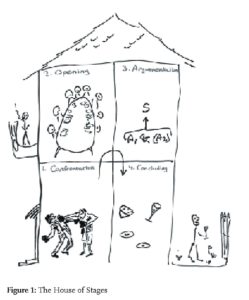ISSA Proceedings 2006 ~ On How To Get Beyond The Opening Stage
1. Introduction
What is the opening stage? And why would it be hard to get beyond it?
The opening stage – as many will know – is one of the four discussion stages contained in the familiar pragma-dialectical model of critical discussion (Van Eemeren & Grootendorst 1984, 1992, 2004), which constitutes a normative model for argumentative activities aimed at the resolution of a difference of opinion. It is one of the merits of this model that, in its description of the ideal argumentative process, it does not limit itself to argumentation in the proper, but narrow, sense of advancing arguments for a standpoint, but includes discussion stages where other necessary steps for the resolution of differences of opinion are located. Remember that there are just four stages, and that they are, in order, the following:
1. Confrontation Stage
2. Opening Stage
3. Argumentation stage
4. Concluding Stage.
Contrary to what may be expected, the opening stage does not figure as the first stage (whereas the concluding stage finds itself indeed neatly placed at the end). This is a vagary of nomenclature that sometimes breeds confusion even among experts. Apart from that, it is clear that the process of argumentation proper has been placed in the third stage, the argumentation stage, and that the first two stages figure as preparatory stages.
The problem I want to discuss actually pertains to both preparatory stages, namely: how can one get them completed, in a satisfactory way and within a reasonable time, to move on to what is properly called argumentation. However I will discuss this problem with special reference to the opening stage.
 To enhance a more lively remembrance of the four stages of discussion you could picture them as a house with four rooms (see Figure 1).
To enhance a more lively remembrance of the four stages of discussion you could picture them as a house with four rooms (see Figure 1).
When guests enter into this house they start on the ground floor in Room 1, a kind of gym – a place suitable for boxing exercises – which represents the confrontation stage, i.e., the stage where a difference of opinion is made explicit. The goal is to get, ultimately, to Room 4, another ground floor room, giving on to the garden, where refreshments are served – drinks and tidbits – which room represents the concluding stage, i.e., the stage where agreements are achieved. Now to get there, our guests have to pass through two other rooms, both on the upper floor, which represent the opening stage (Room 2) and the argumentation stage (Room 3). In Room 3, the actual business of argumentation is going on: for instance, a standpoint S is being supported by argument. But before one gets there, a lot of preparatory work needs to be done. The agenda will be presented in the next section, but one thing that has to be settled is the choice of a system of discussion rules that the parties are going to adhere to. No wonder Room 2 is packed with theorists of argumentation debating these rules. The complexity of issues and the multiplicity of perspectives is making one wonder whether any agreement will ever be reached at all. One would be fortunate to see the people in Room 2 manage to come to an agreement about just the shape of their table. Even that issue can be nasty, as was the case at the opening stage of the Paris Peace Conference about Vietnam. As some will remember, in 1968-69 the shape of the table was debated for months. This, of course, was a case of opening a negotiation dialogue, not a persuasion dialogue or argumentative discussion. Yet, the case of the Paris Peace Conference constitutes a classical illustration of how difficult it may be to get beyond the opening stage of a discussion. (Which is not to say that the issue of the shape of the table was unimportant at the time.)
The rest of this paper will be organized as follows. As I announced before, I shall first present the agenda for Room 2, i.e., a task list for the opening stage, assembled from pragma-dialectic writings (Section 2). Then I shall illustrate these tasks in a dialogue (Section 3), point out some problems (Section 4) and start on some sketch of a way to adapt the architecture of critical discussion in order to overcome these problems (Section 5). Read more
South Africa – The National Association of Social Housing Organisations
Who is NASHO?
The National Association of Social Housing Oganisations – NASHO – is an independent member-based association of 18 well-established social housing institutions (SHIs) across South Africa. NASHO was formed at an inaugural congress held in May 2002 and formally launched by the then National Housing Minister, Sankie Mthembi-Mahanyele.
Collectively, our membership owns and/or manages approximately 24 000 units, providing subsidised rental accommodation for over 115 000 low-to middle income families throughout the country.
NASHO serves its members with advocacy, information, and training. Maintaining strong links between NASHO and its members is a priority for the federation, in order to reduce the isolation of individual members and to ensure that services and information are widely available.
What Is Social Housing?
Social Housing aims to contribute towards restructuring South African society through economic, social, spatial location and functional housing opportunities. It aims to achieve economic empowerment, integration, sustainable human settlements and improving the overall functioning of the housing sector by widening the range of affordable housing options available (rental housing). Social Housing targets facility rich areas, all within walking distance or well connected to the transport network.
Read more: http://www.nasho.org.za/
Saudi Gazette – Slums Highlight Wider Housing Gap
Saudi Gazette. Jan.11, 2014. JEDDAH — The authorities are quietly planning to raze slums in Jeddah to make way for newer, restored neighborhoods as part of a wider plan to keep up with soaring demand for affordable housing.
A gap between what is available on the market and what many Saudis can afford has left people frustrated and accusing officials of corruption. A shortage of low- and middle-income housing means millions of Saudis cannot afford to buy a home.
Young Saudis are especially affected since it takes years of saving before many can afford to buy a home, often a precursor to marriage.
To address the housing shortage and public grumbling, the city of Jeddah is a testing ground for a plan that includes getting rid of most of its roughly 50 unplanned settlements, which comprise a third of its built-up area, according to municipality figures.
In their place, the city plans to build subsidized housing complexes for Saudis.
Read more: http://www.saudigazette.com.sa/20140112192242
Marx, Benjamin (MIT), Stoker, Thomas (MIT) & Suri, Tavneet (MIT) ~ The Economics of Slums in the Developing World
Journal of Economic Perspectives – American Economic Association
The global expansion of urban slums poses questions for economic research as well as problems for policymakers. We provide evidence that the type of poverty observed in contemporary slums of the developing world is characteristic of that described in the literature on poverty traps. We document how human capital threshold effects, investment inertia, and a “policy trap” may prevent slum dwellers from seizing economic opportunities offered by geographic proximity to the city. We test the assumptions of another theory — that slums are a just transitory phenomenon characteristic of fastgrowing economies — by examining the relationship between economic growth, urban growth, and slum growth in the developing world, and whether standards of living of slum dwellers are improving over time, both within slums and across generations. Finally, we discuss why standard policy approaches have often failed to mitigate the expansion of slums in the developing world. Our aim is to inform public debate on the essential issues posed by slums in the developing world.
Full text: http://www.aeaweb.org/
Rock Art Research in South Africa

Therianthropes and trance dance from artwork painted by Kalahari artist, the late Vetkat Regopstaan Kruiper (with permission)
Ethno-archaeology: Oral narratives and rock art
The focus of my research is on the method of recording oral narratives and their link to, and possible use in, the interpretation of rock art, specifically rock engravings. Research on indigenous knowledge and artefacts falls within a contentious area of indigenous archaeology associated with colonialists’ geographic and intellectual imperialism. It is necessary for my contextual approach to include, as in the exploration of myths, the theoretical setting of ethno-archaeology within which my research takes place. In the discipline of archaeology the use of ethnography falls under what Renfrew and Bahn (1991: 339) call ‘What did they think?’ The use of ‘they’ points not only to ethical issues of ‘othering’, the negative artificial construction of two camps of cultures and the corresponding approaches of scholars and present day descendants of the artists, but also to the time gap between the artists of the past and the present (Lewis-Williams & Pearce, 2004).
The rock paintings situated in caves, shelters and on portable stones, mostly in the mountainous regions in South Africa, and rock engravings situated predominantly in the plateau areas, on boulders on hills or near rivers, date mostly from within the last few thousand years. However, small mobiliary painted stones from Apollo 11 Cave and an engraved ochre piece from Blombos Cave date from some 25 000 and up to 70 000 years ago respectively (Lewis-Williams & Pearce, 2004). This considerable antiquity complicates any attempts at interpreting the rock art by way of oral narratives, even those recorded by the earliest colonialists. Furthermore, our views and therefore theories on art, oral narrative and methodology are constantly changing (Bahn, 1998).
University Of Minnesota – Human Rights Resource Center – The Right To Adequate Housing
 Housing forms an indispensable part of ensuring human dignity. “Adequate housing” encompasses more than just the four walls of a room and a roof over one’s head. Housing is essential for normal healthy living. It fulfills deep-seated psychological needs for privacy and personal space; physical needs for security and protection from inclement weather; and social needs for basic gathering points where important relationships are forged and nurtured. In many societies, a house also serves an important function as an economic center where essential commercial activities are performed.
Housing forms an indispensable part of ensuring human dignity. “Adequate housing” encompasses more than just the four walls of a room and a roof over one’s head. Housing is essential for normal healthy living. It fulfills deep-seated psychological needs for privacy and personal space; physical needs for security and protection from inclement weather; and social needs for basic gathering points where important relationships are forged and nurtured. In many societies, a house also serves an important function as an economic center where essential commercial activities are performed.
Despite global recognition of the importance of housing to human welfare and survival, it is estimated that over one billion people live in inadequate housing while over 100 million people are homeless. Governments claim lack of capacity and resources to implement programs and undertake reforms aimed at creating the conditions for expanding access to housing. The right to adequate housing therefore provides a unique paradigm for monitoring the steps taken by states towards the provision of housing through citizens’ demands and insistence upon the fulfillment of this basic human right.
Read more: http://www1.umn.edu/edumat/module13.htm



